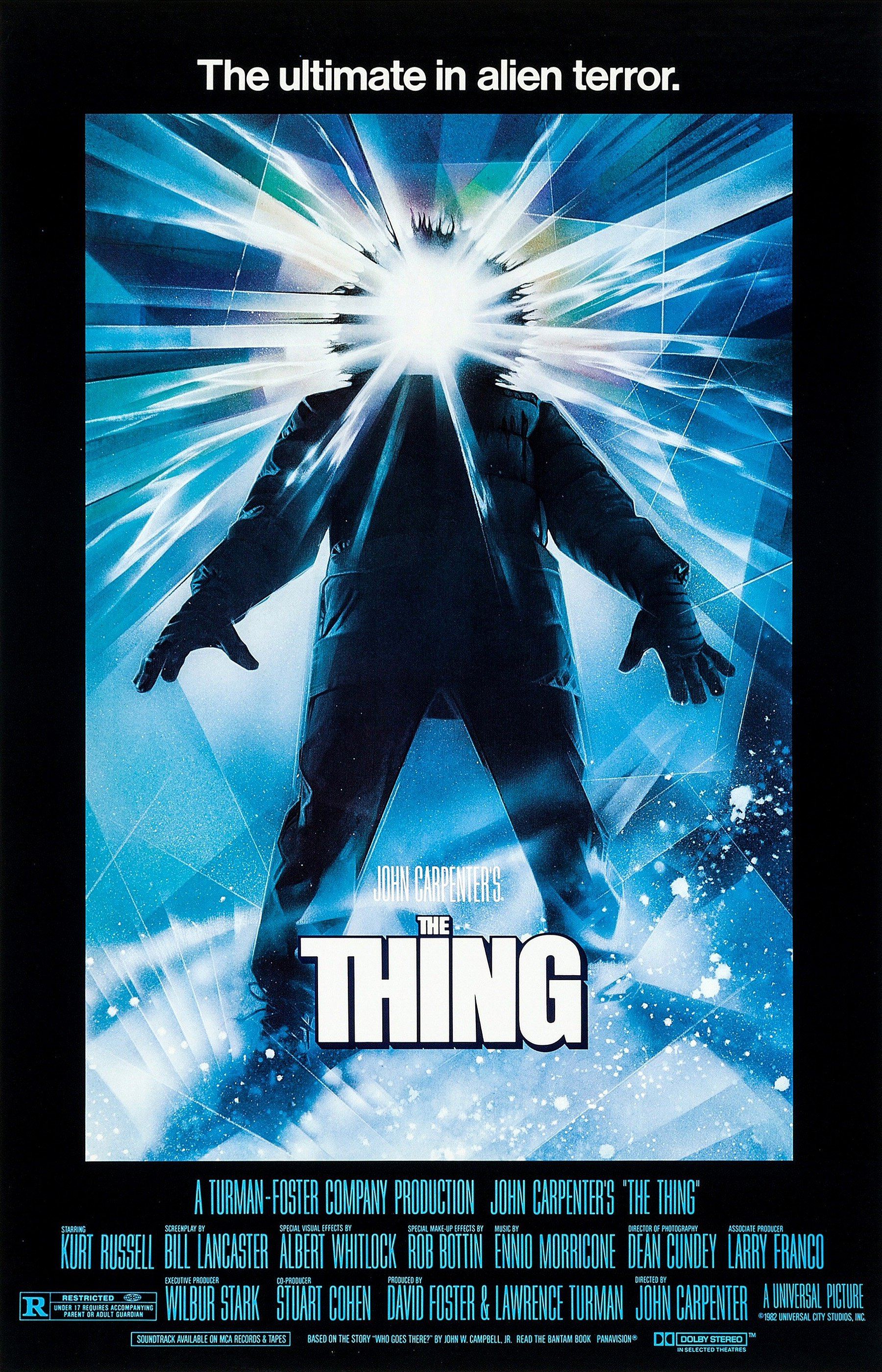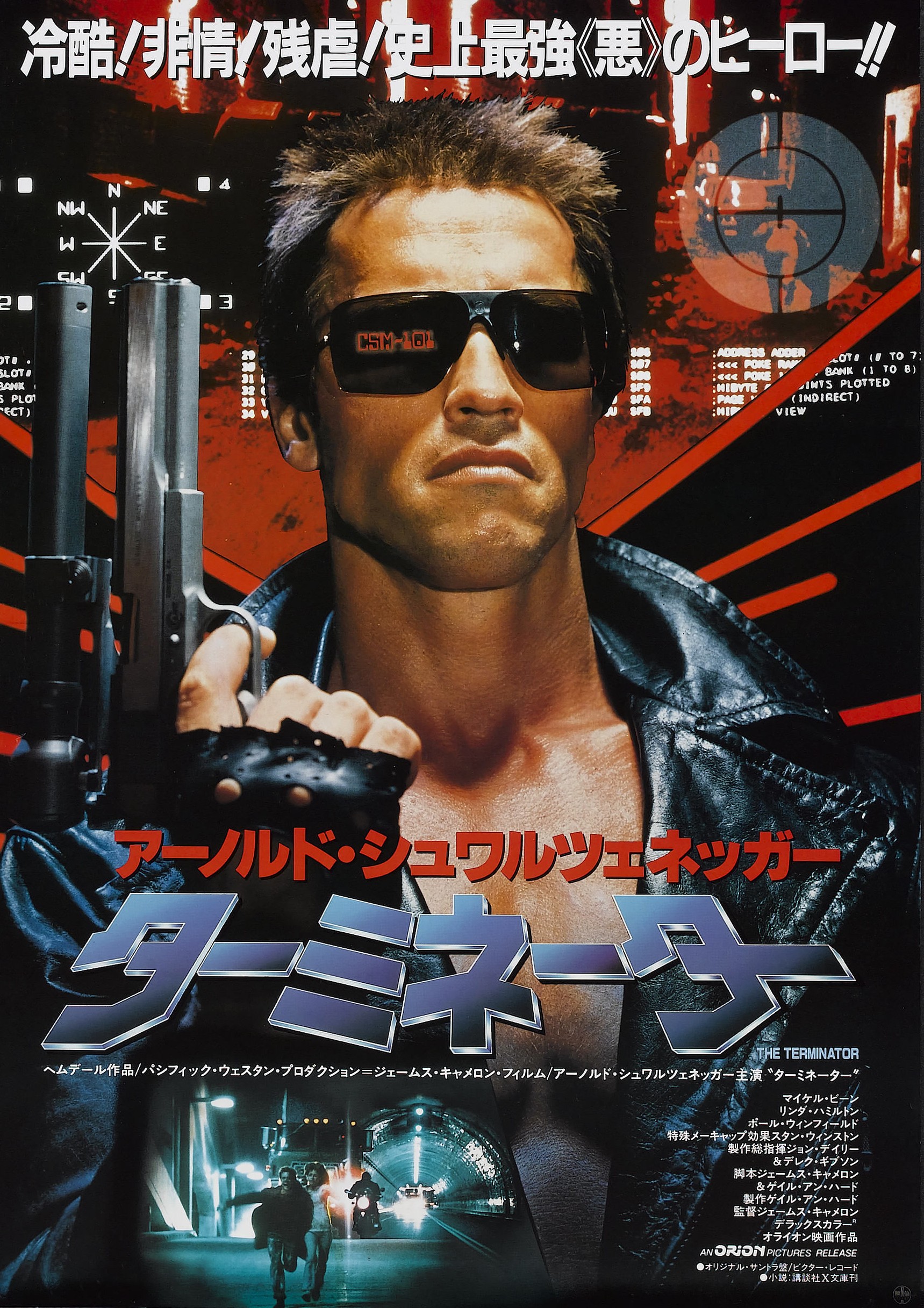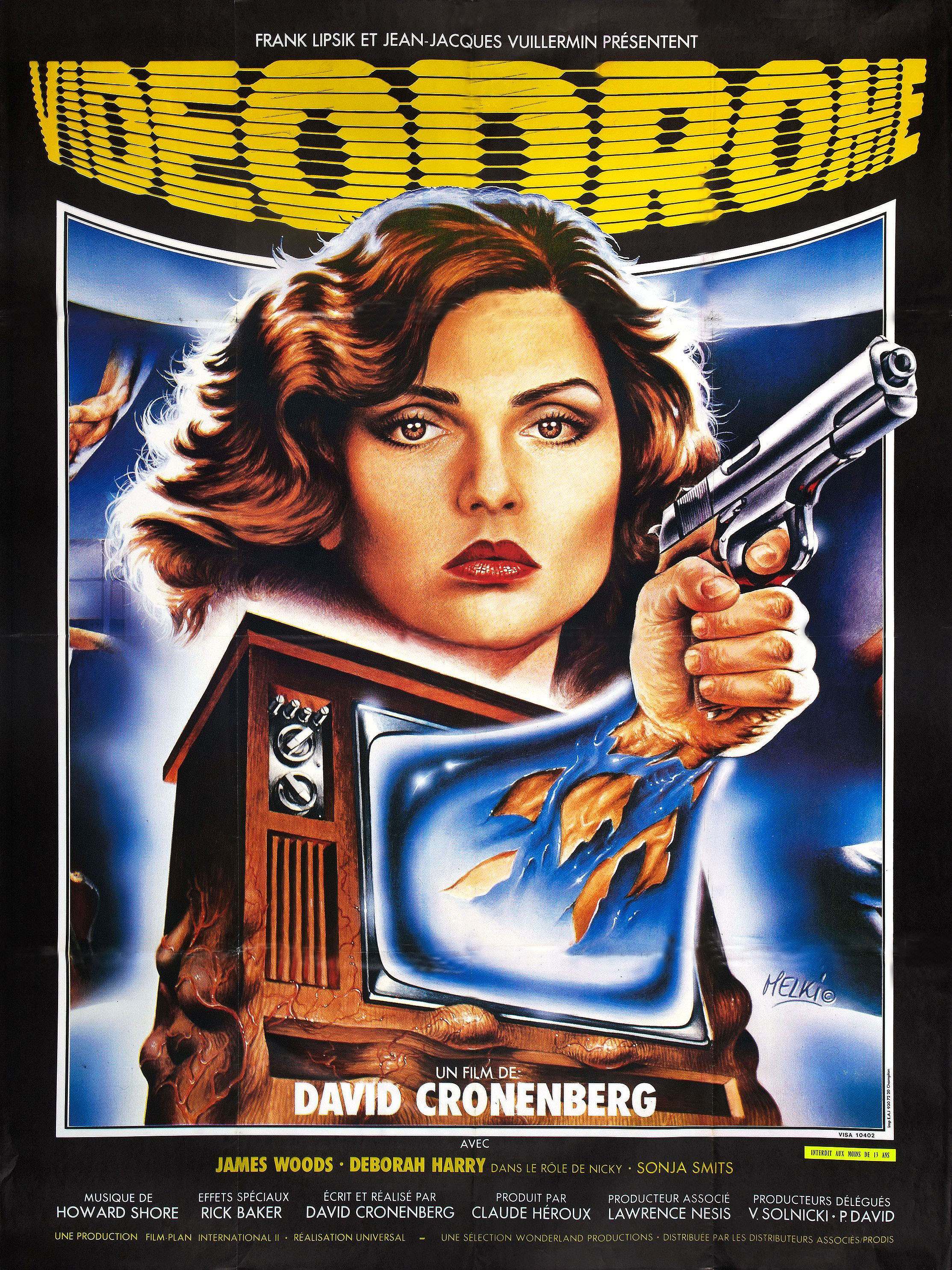80s Sci Fi Movie Posters

VHS Revival brings you some of the finest promotional treats of the 1980s
The Thing (1982)
In his prime, John Carpenter made some of the most memorable movies of his era. So consistent and diverse were works such as Halloween, Escape From New York and They Live it is almost impossible to choose an outright best, and when it comes to his accompanying artworks, it doesn't get much easier.
Like his movies, Carpenter's promotional catalogue features a wealth of striking images, but this poster for The Thing — a superior remake of 1952's The Thing from Another World — is one of the most iconic of the entire genre, a work of striking simplicity that perfectly captures the film's central theme.
One of Carpenter's go-to artists was the legendary Drew Struzan, a name you will be hearing more of before this list is through. Struzan's extensive catalogue features some of the most impressive promotional images of the 1980s, and his work onThe Thing right up there with the very best of them.

For those of you who still haven't seen this movie, shame on you. The story of a molecular menace with the ability to assimilate other organisms, The Thing is set at a remote Antarctic outpost. It is here where our insidious, shape-shifting entity goes to work, feasting on the members of a US research station, a beleaguered group who are immediately plunged into a self-defeating state of paranoia as tensions rise and identity becomes an illusion.
The above images' looming silhouette, its face fragmented by a flash of blinding splinters, encapsulates the movie's themes with a sublime, spoiler-free proficiency. Complete with fur-lined hood, this figure could be any one of the doomed outpost crew, the exploding blankness of its face revealing everyone and no one at all. Add to this a fading blanket of stars and a fractured, glacial background, and what we're left with is a kaleidoscopic work of immense beauty that hints at the distorted horrors in store.
E.T. the Extra-terrestrial (1982)
Taking over from Star Wars as the most successful movie ever made, Steven Spielberg'sE.T. the Extra-terrestrial would take cultural marketing and mainstream commercialism to a whole new stratosphere as Hollywood geared up for the 80s revolution, and a huge part of E.T.'s unprecedented commercial power was this tantalising promotional poster.
The movie that began the 'kids in peril' formula that would prove so successful, E.T. is the story of a young boy who befriends an extra-terrestrial stranded on Earth, recruiting the help of his friends and infant sister as he attempts to keep the creature out government hands long enough for him to return to his home planet.

Another from the easel of Spielberg go-to artist John Alvin, one of the most famous images in all of cinema was of course inspired by Michelangelo's painting The Creation of Adam, its universal 'touch' an inspired choice for the studio's attempts to connect with a global audience. It also represents the movie's most touching moment, our peewee protagonist tapping into surrogate father themes synonymous with the director.
The E.T. character is based on an imaginary alien friend that Spielberg created as a way to deal with his parents' divorce. Alvin presents the creature as something of a mystery, alluding to the mysterious wonders of outer space. It worked a treat, E.T. the Extra-terrestrial raking in a whopping $663,400,925 worldwide during its initial release.
The Terminator (1984) (Japanese Version)
Arnold Schwarzenegger became a household name after his turn as an irrepressible killing machine sent back in time to stop mankind in its tracks, and the intimidating still used for the movie's promotional poster tells you everything you need to know about Arnie's suitably heartless performance.
Arnie's T-800 was a seemingly indestructible behemoth, and director James Cameron was smart enough to cast the rookie actor, utilising his wooden demeanour and dehumanising accent to devastating effect. Naturally, he also capitalised on the kind of superhuman physique first brought to mainstream attention in 1977's bodybuilding docudrama Pumping Iron, a movie that glimpsed the future governor of California's unwavering sense of ambition.

Here we have the Japanese version of that poster — a country renown for their wacky variations on Western images. In this case, they made the unusual decision of deviating only very slightly from the original. As is typical of the country's style, those responsible added a small still from the movie, but asides from that minute difference they wisely chose to retain much of what is a truly iconic poster.
So why not stick with the original American version? Put succinctly: language. Viewed through foreign eyes, there is something much more appropriate about the Japanese written language when it comes to cyborg killing machines. You can put this down to sweeping stereotypes or just plain ignorance on my part, but the Japanese spelling of The Terminator looks infinitely more advanced in my eyes, and infinitely cooler.
Back to the Future (1985)
Can you really have an 80s movie list without featuring Robert Zemeckis' time-travelling extravaganza? If the film's promotional poster had proven sub-par, then possibly. Fortunately, it is just as memorable as the film itself, and is still a fixture on college campus' around the world more than thirty years after the film's release.
In terms of cute symbolism, this original one-sheet forBack to the Future pales to much of what you will find out there. Even so, it is arguably the most iconic promotional poster of the decade, one that oozes 80s excess, capturing the energetic appeal of the movie's marquee star. From the outmoded fashion to the neon pastels and dramatic trail of blazing fire, Drew Struzan's iconic promotional work is a visual time capsule whose importance as a window into the decade cannot be overlooked.

One of a plethora of Spielberg-produced wonders that would help define the decade, Back to the Future was an immediate smash that spoke to kids and adults alike with its winning mix of juvenile adventure and period nostalgia. A heartwarming thrill ride with a winning soundtrack and a series of precocious performances, its impact would be immediate and immutable, its appeal timeless, and Struzan's promotional piece would not let the side down.
Such was the poster's perfection that the same image was used for both sequels, each adding an extra character to the hectic fray, but not to be underestimated is the importance of the film's logo, a title of warped perspective that sums up the fun nature of its back-in-time escapades.
Blade Runner (1982)
Ridley Scott's barren study of the human condition, juxtaposed with a race of androids known as 'replicants', is one of the most visually breathtaking and literary science fiction movies ever realised.
Based on Phillip K Dick's novelDo Android's Dream of Electric Sheep, the movie explores themes of alienation, genetic engineering, technicism and religious symbolism, the latter personified by Eldon Tyrell's god on Earth — a genetics mogul whose advancements force the hand of the LAPD and Rick Deckard's retired blade runner.
Buoyed by one of the greatest cinematic scores ever realised, Blade Runner is a deeply philosophical work drenched in the toxic landscape of neo-noir, one that questions our capacity for empathy in a technological world that has become seeped in paranoia.

The above poster encapsulates Scott's vision with a deftness and skill that typifies the canvas-based poster art synonymous with the era. Artist John Alvin's depiction of Blade Runner's futuristic cityscape speaks for itself, his decision to make the movie's love story central to the piece meeting noir convention while highlighting Dick's central theme of what it is to be human, pairing Rachael's 'undetectable' replicant with Deckard's dubious human-come-android.
Science fiction has rarely been richer.
The Fly (1986)
Be afraid. Be very afraid.
And we were. At least I was when I spied the trailer for David Cronenberg's first commercial smash The Fly. After struggling to break free from the mainstream turn-off that was the body horror sub-genre, the director would briefly flirt with convention, his distinctly cold and bloated adaptation of Stephen King'sThe Dead Zone earning mixed reviews and a comparatively scant return.
Three years later, the inimitable director would return to his roots armed with a wonderful cast and big bucks practical effects, this time remaking kitsch Vincent Price vehicle The Fly and updating it for an audience consumed by the AIDS epidemic of the 1980s — a metaphor that turned out to be unintentional on the part of the director.

The story of an obsessive scientist transformed into a human/fly hybrid while attempting teleportation, the movie would win an Academy Award for Best Makeup, finally announcing Cronenberg as a Hollywood player with a visual banquet that left the movie-going public twitching with revulsion.
Much like the movie's tagline, the film's striking promotional accompaniment is shrouded in mystery, creeping out of the darkness in a way that pays homage to the movie's creature feature roots, hinting at the production's practical effects upgrade with a largely concealed image of something acutely unnatural. Its simple juxtapose of blinding light and pitch blackness speaks to the protagonist's rebirth and the conflicting personalities it will ultimately spawn.
No wonder the movie was such a hit.
Videodrome (1983)
Another entry for Cronenberg comes in the form of this French poster for his 1983 body horror classic Videodrome. A commercial flop upon release, the movie's prescient themes would only grow in relevance, speaking to our ever growing dependency on technology and its capacities as a conduit for systematic propaganda.
The story of a smut-peddling civic TV exec who stumbles upon the darker corners of the VHS market, the movie's emphasis on 'snuff' filmmaking would coincide with the home video censorship scandal of the early 1980s, an attack on civil liberties that saw filmmakers prosecuted in a court of law for violations of the Obscene Publications Act.

For those of you who have had the dubious pleasure of seeing Videodrome, the above poster hints at some of the movie's most iconic scenes, concentrating not on protagonist Max Renn (James Woods), but on the equally iconic Debbie Harry, the Blondie lead singer becoming a symbol of Renn's shameful passions and descent into politically motivated assassination.
While its warped framing hints at the movie's multiple realities, the poster focuses on Rick Baker's mind-bending practical effects set-pieces, and the perversely human guise they adopt as Renn spirals further into the realms of fantasy. Other than that, it is a beautiful example of canvas art that would look spectacular on any wall.
C'est magnifique!
The Empire Strikes Back (1980)
One of the most highly anticipated movies of all time, The Empire Strikes Back is considered by many to be the greatest entry in the Star Wars canon, a distinctly dark instalment that led to one of the most shocking reveals in all of cinema. It is also one of the few sequels that's actually considered superior to the original, one that would see the resurgence of 'the dark side' as Luke and his rabble of freedom fighters were forced to regroup.
In terms of promotional art, there were actually a few variations commissioned forThe Empire Strikes Back. Star Wars artist Tom Jung would return to the commercial fray with another masterclass of his own, but the version featured here was the work of Jaws artist Roger Kastel, who arguably produces the best poster of the entire series.

The character likenesses of Luke, Han and Leia speak for themselves, but the poster's composition is perhaps even more impressive. While the likes of Chewy, R2-D2 and C-3PO linger suitably on the fringes, it is the trilogy's blossoming romance that takes centre stage, the movie's love interest smartly relegating Luke's lonesome warrior to the less emphatic, but still highly relevant foreground.
But 'Empire' is all about one character, the dark side's emblematic tyrant Darth Vader, whose omnipotent presence lingers in a way that is both peripheral and all-consuming. The fact that he blends with outer space gives him an almost God-like aura. Similarly, the subtle ice colours featured in the bottom half of the image make the planet Hoth quietly central to the piece. It's not easy to sum up a movie of Empire's enormous scope in one image, but Kastel achieves it with typical aplomb.
Brazil (1985)
Terry Gilliam's Python-esque ode to Orwellian dystopia, Brazil, is a vaudevillian grotesquery with a deeply sobering underbelly. Tackling themes such as government surveillance, industrialism and Libertarian terrorism, it is also deeply satirical, featuring a series of spectacular images that range from the heavenly to the nightmarish, all of it punctuated by a grandiose, if ultimately doomed quasi-romance.
Tapping into inspiration Phillip K Dick's literary multiplicities, the movie would feature an ensemble cast of some of the industry's finest actors, but would ultimately flounder at the US box office due to its abstract tone and un-American philosophies.

Ultimately, Gilliam's masterpiece is all about presentation, its grey conformities counterbalanced by luscious set designs and warped perspectives, the kind of visuals that superbly satirise the dysfunction of hyper bureaucracy.
Its accompanying poster captures that very juxtapose. While the neon title casts a fleeing angel's shadow upon endless rows of filing cabinets, a single document escapes its dreary confinements to give chase, floating like the movie's central character towards a fate that is both startlingly elusive and painfully inevitable.
Simply stunning.
Escape From New York (1982)
There are so many variations of promotional art for Escape From New York, each as iconic as the next, that this decision proved rather difficult, and though the Italian version would run it close, I decided on the following masterwork by poster artist Barry E. Jackson, one based on art director David Renerick's vision of the Statue of Liberty's head lying in the middle of a street in an imperialist future New York.
An urban western that would act as a commentary on Reaganite politics, Escape From New York is the story of a former soldier-turned-thief sent to rescue the president after he crash-lands on Manhattan Island, now a maximum security prison for the nation's baddest, as well as anyone else the government decides to throw away.

Protagonist Snake Plissken — the not too subtle inspiration for the first truly cinematic video game in Metal Gear Solid — would become one of the genre's most iconic figures, an unwilling emblem of freedom with a pirate eyepatch and a Clint Eastwood snarl who would transform actor Kurt Russell into a global sci-fi icon.
No doubt taking inspiration from 1968's Planet of the Apes, the dilapidated Lady Liberty takes centre stage — a colossal emblem of democracy's total dissolution. The image captures New York's wild west with a crumbling cityscape of grandiose perspective. Asides from its symbolism and political clout, the image is an aesthetic wonder that represents the prison's crumbling society beautifully, with great likenesses and the kind of artistic detail that would lendEscape From New York the epic aura it so richly deserves.
80s Sci Fi Movie Posters
Source: https://vhsrevival.com/2019/01/31/greatest-movie-posters-of-the-80s-sci-fi-edition/
Posted by: santosandesell.blogspot.com

0 Response to "80s Sci Fi Movie Posters"
Post a Comment